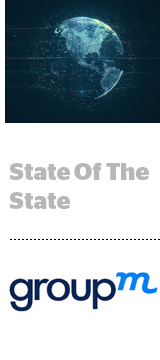
GroupM’s State of Digital report, released Thursday, predicts a year of CPM inflation and ecommerce growth as the duopoly maintains its stronghold over the digital economy.
Marketers in 2017 spent 44% of their digital budgets programmatically, according to the report. That’s up from 31% in 2016, and GroupM predicts it will rise to 47% in 2018.
GroupM defines “programmatic” as any digital investment transacted automatically.
The report – which breaks down 2017 trends across data and tech, video, investment and viewability and verification – also found that the ad tech tax has risen to roughly 20% in the US, with buy- and sell-side taxes averaging at 10% each.
Inventory Inflation
GroupM predicts that programmatic display and video CPMs are both set to rise in 2018.
Video CPMs are inflating as marketers look for quality inventory and struggle to measure effectiveness. GroupM calls out North America as an “inflation hot spot,” for video, where CPMs were up 5% to 13% in 2017 depending on supplier, weight of investment and whether or not the buy was guaranteed.
Programmatic display CPMs are also rising as viewability gets better across the web and low-quality supply drops with the rise of programmatic direct deals.
Header bidding is also driving up CPMs on digital inventory by allowing publishers to manage yield better and get more for their premium inventory. And an uptick in first-price auctions is pushing clearing prices higher and leading to inflation, said Adam Smith, futures director at GroupM.
“Price inflation isn’t always about supply and demand,” he said. “It’s about the structure of the market, and header bidding and first price auctions are part of that structure.”
GDPR could cause inflation to rise even higher in 2018, Smith predicts, if the number of users who consent to receive targeted digital advertising drops dramatically.
“If sustained demand for digital ad audiences meet what could be a restrained supply, that is inherently inflationary,” he said. “The other side of the coin is that advertisers may hesitate to increase investment until this plays out.”
Duopoly Still Dominates
Despite brand safety mishaps, fake news scandals and privacy issues, both Google and Facebook still dominate.
YouTube is the “platform of choice” for marketers who want to reach light TV viewers, the report said, and more marketers are choosing DoubleClick Bid Manager as their DSP, although the report didn’t break out numbers.
Marketers spent 22% of their budgets on online video in 2017, up from 17% in 2016. And Google’s six-second video ad unit has become advertisers’ preferred format, garnering 90% view through rates in the UK, Smith said.
“There’s a beginning of a consensus now around the six-second time length,” he said. “Shorter time lengths are more versatile.”
Within the Facebook ecosystem, investment on Instagram is on the rise as marketers look to reach young audiences. But Smith predicts that as direct response marketers create smarter attribution models that move away from last-click, Facebook’s dominance could start to slip.
“Attribution intelligence will improve, and that may be a reason to moderate Facebook investment,” he said.
Blockchain knockdown
Despite the hype, blockchain is “slow, clunky and expensive … peddled by self-interested suppliers and advisers and, in its present state, could not keep up with the demands of real-time media,” GroupM said.
When it comes to blockchain as an application for marketing, “Hardly anybody really knows what they’re talking about,” Smith said.
“Blockchain is an intriguing technology if you’re trying to solve a really difficult problem,” he said. “A large amount of digital is programmatic now. Blockchain can’t run fast enough to keep up.”
Ecommerce boom
For Smith, the biggest story was in the growth of ecommerce, which grew 17% year over year to $1.8 trillion. The average basket size for an ecommerce shopper also grew 10% to almost $1,000 per year, and GroupM predicts it will grow the same amount this year.
“Ecommerce growth is really eating into the retail space now,” Smith said. “Basket size increasing wasn’t just a function of more people getting online. Now, people are spending more.”
This year, GroupM predicts, the global ecommerce market will grow 15% to top $2.4 trillion – and represent 10% of all retail sales.
“The progress of ecommerce bears a striking resemblance to that of digital ad expenditure,” the report said.
Western ecommerce markets can take a hint from China, however, whose marketers are doing a better job of branding on ecommerce platforms, Smith said.
“What stands out in China’s ecommerce market are aspirational brands at an affordable price supported with advertising,” he said. “I don’t think there is quite this attrition of lower-level, new-entry products. There’s something there for western marketers to look at.”
This post was syndicated from Ad Exchanger.

More Stories
Roku Extols The Virtues Of Third-Party Programmatic Partnerships
Newsable wins Best Audio Product at Global Media Awards
How The Sports Bra Sold Its Game Plan to the World